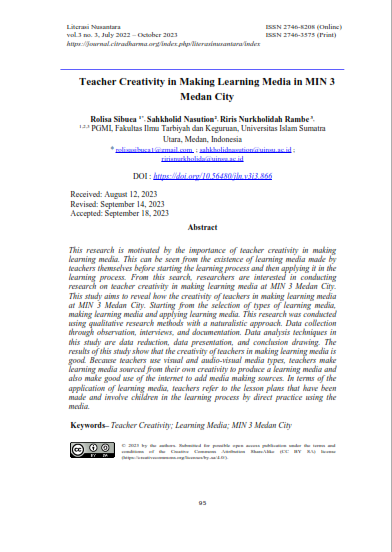Teacher Creativity in Making Learning Media in MIN 3 Medan City
DOI:
https://doi.org/10.56480/jln.v3i3.866
 Abstract View:
Abstract View:
148
 PDF downloads:
PDF downloads:
135
Keywords:
Teacher Creativity, Learning Media, MIN 3 Medan CityAbstract
This research is motivated by the importance of teacher creativity in making learning media. This can be seen from the existence of learning media made by teachers themselves before starting the learning process and then applying it in the learning process. From this search, researchers are interested in conducting research on teacher creativity in making learning media at MIN 3 Medan City. This study aims to reveal how the creativity of teachers in making learning media at MIN 3 Medan City. Starting from the selection of types of learning media, making learning media and applying learning media. This research was conducted using qualitative research methods with a naturalistic approach. Data collection through observation, interviews, and documentation. Data analysis techniques in this study are data reduction, data presentation, and conclusion drawing. The results of this study show that the creativity of teachers in making learning media is good. Because teachers use visual and audio-visual media types, teachers make learning media sourced from their own creativity to produce a learning media and also make good use of the internet to add media making sources. In terms of the application of learning media, teachers refer to the lesson plans that have been made and involve children in the learning process by direct practice using the media.
References
Huda, S. A. (2020). "Guru kreatif di masa pandemi covid-19". Jurnal Kar, 5(1), 21–32. https://doi.org/10.30736/atl.v5i1.508
Hulbat, R. (2023). Kreatifitas Guru Pai Dalam Meningkatkan Minat Belajar Di Kelas X Madrasah Aliyah Negeri 3 Hulu Sungai Tengah. Adiba: Journal of Education, 3(1), 55–63. https://doi.org/https://doi.org/10.30596/jmp-dmt.v1i3.5670
M. Ramli. 2021. “Media Pembelajaran Dalam Perspektif Al-Qur’an Dan Al-Hadits.” Jurnal Literasiologi 6 (1): 130–54.
https://doi.org/10.47783/literasiologi.v6i1.242.
Marwan, Abu Yahya. 2014. “Tafsir Al-Quran Hidayatul Insan Jilid 2.” Tafsir Hidayatul Insan, 1–17.
Nurhanifah, Siti. 2018. Kreativitas Guru Dalam Mengembangkan Media Pembelajaran Di TK B TKIT Raudhatul Jannah Bogor. Skripsi.
Pito, Abdul haris. 2021. “Konsep Media Pembelajaran Dalam Perspektif Alquran.” Ilmuna: Jurnal Studi Pendidikan Agama Islam 3 (2): 87–101. https://doi.org/10.54437/ilmuna.v3i2.228.
Rambe, Riris Nur Kholidah. 2018. “Penerapan Strategi Index Card Match Untuk Meningkatkan Hasil Belajar Siswa Pada Mata Pelajaran Bahasa Indonesia.” Jurnal Tarbiyah 25 (1). https://doi.org/10.30829/tar.v25i1.237.
Relisa, Yunita Murdiyaningrum, and Siska Lismaynati. 2019. Kreativitas Guru Dalam Implementasi Kurikulum 2013. Badan Penelitian Dan Pengembangan Pusat Kementerian Pendidikan Dan Kebudayaan.
Rizki, Agam Muhammad. 2022. “Kreatifitas Mengajar Guru Program Praktikan Prodi Pendidikan Agama Islam.” Skripsi, no. 8.5.2017: 2003–5. https://www.who.int/news-room/fact-sheets/detail/autism-spectrum-disorders.
Rohani. 2019. “Diktat Media Pembelajaran.” Fakultas Ilmu Tarbiyah Dan Keguruan Universitas Islam Negeri Sumatera Utara, 1–95.
Rusman. 2017. Belajar Dan Pembelajaran Berorientasi Standar Proses Pendidikan. 1st ed. Jakarta: Kencana Jakarta.
S Sadiman, Arief, R Rahardjo, Hanung Haryono, and Harjito. 2014. Media Pendidikan Pengertian, Pengembangan, Dan Pemanfaatannya. 1st ed. Depok: PT.Raja Grafindo Persada.
S Zainaiyati, Husniyatus. 2017. Pengembangan Media Pembelajaran Berbasis ICT KOnsep Dan Aplikasi Pada Pembelajaran Pendidikan Agama Islam. Jakarta: Kencana Jakarta.
Salim. 2019. Metode Penelitian Kualitatif. Bandung: Cita Pustaka Media.
Sudarma, Momon. 2013. Profesi Guru : Dipuji, Dikritisi, Dan Dicaci. 1st ed. Jakarta: PT.Raja Grafindo Persada.
Sudaryono. 2021. Metodologi Penelitian Kuantitatif, Kualitatif, Dan Mix Method. Depok: PT.Raja Grafindo Persada.
Sundayana, Rostina. 2016. Media Dan Alat Peraga Dalam Pembelajaran Matematika. Edited by Imas Komariah and Daeng Nurjamal. 3rd ed. Bandung: Alfabeta.

Downloads
Published
How to Cite
Issue
Section
Categories
License
Copyright (c) 2023 Rolisa Sibuea, Sahkholid Nasution, Riris Nurkholidah Rambe

This work is licensed under a Creative Commons Attribution-ShareAlike 4.0 International License.
Copyright Notice
Authors who publish with this journal agree to the following terms:
- Authors retain copyright and grant the journal right of first publication with the work simultaneously licensed under a Creative Commons Attribution-ShareAlike 4.0 International License that allows others to share the work with an acknowledgment of the work's authorship and initial publication in this journal.
- Authors are able to enter into separate, additional contractual arrangements for the non-exclusive distribution of the journal's published version of the work (e.g., post it to an institutional repository or publish it in a book), with an acknowledgment of its initial publication in this journal.
- Authors are permitted and encouraged to post their work online (e.g., in institutional repositories or on their website) prior to and during the submission process, as it can lead to productive exchanges, as well as earlier and greater citation of published work (See The Effect of Open Access).

This work is licensed under a Creative Commons Attribution-ShareAlike 4.0 International License.





























